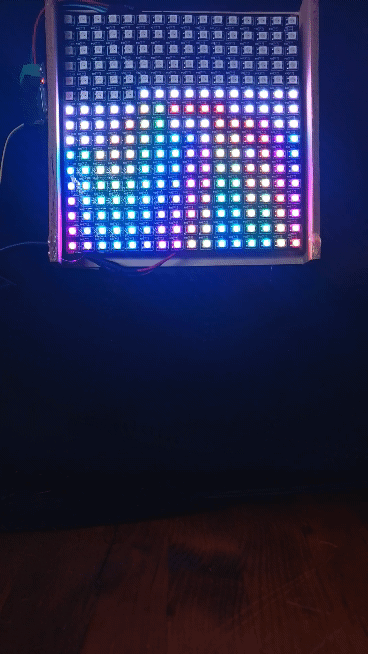I decided to have a play with the accelerometer and came up with the “bouncing ball” pattern below, inspired by this project. If you don’t have an accelerometer, you can uncomment line 113 to make the balls “rebounce” automatically once they have stopped bouncing. This should also work on a strip if you set the width to 1 (though I haven’t tried that yet).
If anyone has any feedback let me know and I’ll try and incorporate it before uploading to the pattern library.
// Set this to the width of your matrix
var width = 24
var height = pixelCount / width
// Acceleration of gravity in m/s^2
export var gravity = -9.81
export function sliderGravity(v) {
gravity = -v * 29 - 1
resetAll()
}
// How sensitive the pattern is to movement from the accelerometer
export var motionThreshold = 0.03
export function sliderMotionSensitivity(v) {
motionThreshold = v * v * 0.07055 + 0.0195
}
// Whether or not to draw a rainbow pattern under the bouncing balls
export var rainbow = 1
export function sliderShowRainbow(v) {
rainbow = v >= 0.5
}
export var randomness = 100
export function sliderRandomness(v) {
randomness = v * v * 500
}
function initGravity() {
impactVelocityStart = sqrt(-2 * gravity * startHeight)
}
// Get accelerometer info from the sensor expansion board - 3 element array with [x,y,z]
export var accelerometer
var debounce = 0
var prevAccel = array(3)
var diff = array(3)
var dampening = 0.9 // How much dampening to apply to each ball after it bounces
var startHeight = 1 // Starting height of the ball, in meters
var impactVelocityStart
// Keep track of multiple balls, one per vertical strip
var ballHeight = array(width) // Current height of each ball.
var impactVelocity = array(width) // The current impact velocity of each ball. This decreases with each bounce.
var timeSinceLastBounce = array(width) // How long since the last bounce. This helps calcuate the new height.
var startDelay = array(width) // How long a delay before each ball starts bouncing. The 'Randomness' slider
// affects this.
function resetAll() {
initGravity()
for (i = 0; i < width; i++) {
init(i)
}
}
// Reset a ball so it starts bouncing again
function init(i) {
ballHeight[i] = 0
impactVelocity[i] = impactVelocityStart
timeSinceLastBounce[i] = 0
startDelay[i] = random(randomness)
}
resetAll()
export function beforeRender(delta) {
xa = accelerometer[0]
ya = accelerometer[1]
za = accelerometer[2]
diff[0] = abs(xa - prevAccel[0])
diff[1] = abs(ya - prevAccel[1])
diff[2] = abs(za - prevAccel[2])
totalAccel = sqrt(xa * xa + ya * ya + za * za)
debounce = clamp(debounce + delta, 0, 2000) // Prevent overflow
// Bounce all the balls if sensor board is shaken, no more than every second
if (debounce > 1000 && totalAccel > motionThreshold) {
debounce = 0
resetAll()
}
for (i = 0; i < width; i++) {
// If this ball's startDelay hasn't expired, don't do anything yet
if (startDelay[i] > 0) {
startDelay[i] -= delta
continue
}
timeSinceLastBounce[i] += delta
time = timeSinceLastBounce[i] / 1000
ballHeight[i] = 0.5 * gravity * time * time + impactVelocity[i] * time
// Check if the ball has reached the bottom of the strip. If so, bounce it
if (ballHeight[i] < 0) {
ballHeight[i] = 0
impactVelocity[i] *= dampening
timeSinceLastBounce[i] = 0
// If the ball has (nearly) stopped moving, we can kick it back up to full bounce.
// This is useful if you don't have an accelerometer.
if (impactVelocity[i] < 1) {
// init(i)
}
}
}
}
export function render2D(index, x, y) {
xPixel = floor(x * width)
yPixel = height - 1 - floor(y * height)
yBall = floor(ballHeight[xPixel] * height)
if (yPixel == yBall) {
rgb(1, 1, 1)
} else if (rainbow && yPixel < yBall) {
hsv((yBall - yPixel) / height + wave(x), 1, 1)
}
}

